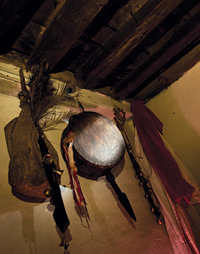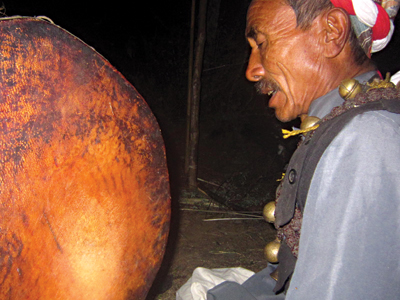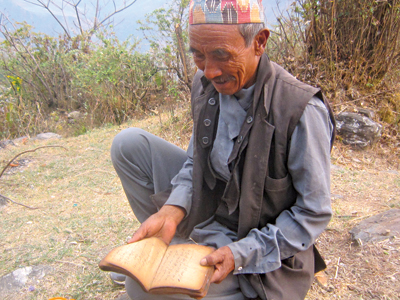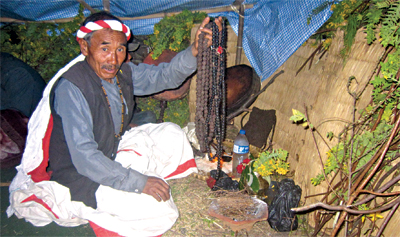Shamanism finds contemporary significance in the lives of Nepal’s far-flung villages
A man by the name of Tej Bahadur Yonjan lives in the village of Karthali in Sindhupalchowk district. For the past 43 years, villagers have employed him to cure all manners of health problems. He is one of thousands of shamans who live and work around the rural areas of present day Nepal.
 The word for shaman in Tej Bahadur’s Tamang mother tongue is Bombo. Of the seven types of Tamang bombo sects, he is a bombo of the Shele Bon kind. Acting as my guru for two nights, Tej Bahadur recently initiated me into the world of Shele Bon, introducing me to some of its occult myths, tantric rites and secret mantras.
The word for shaman in Tej Bahadur’s Tamang mother tongue is Bombo. Of the seven types of Tamang bombo sects, he is a bombo of the Shele Bon kind. Acting as my guru for two nights, Tej Bahadur recently initiated me into the world of Shele Bon, introducing me to some of its occult myths, tantric rites and secret mantras.
On the afternoon before my initiation, Tej Bahadur explained many illuminating things to me. The bombo’s sworn enemy is the witch or bokshi. Since times immemorial, they have been at war. There are only two causes of physical and mental illness in the bombo’s etiology: the curse of a bokshi and the influence of a malevolent ghost (bhoot) or sprite (praet). Motivated by evil intentions, bokshis lay curses on innocent villagers, while the mere sight of a bhoot or praet can cause serious illness. There is another important spirit entity in Nepali folklore called the forest shaman or ban jhankri. Tej Bahadur describes him as a small, hairy, forest dwelling creature who is in fact the bombo’s most powerful protector-deity. However, catching sight of the ban jhankri may again cause serious illness to an ordinary villager. When Tej Bahadur heals illnesses, he must summon protector-deities to enter his body and instruct him on a suitable course of action to cast out the illness from the body of his patient. I was going to learn to summon these protector deities during my initiation.
 The bombo’s drum or dyangro is the key that unlocks the spirit world. When a bombo beats his dyangro and chants mantras passed down to him through an ancient oral tradition, he is summoning his protector deities. Since all spirit-entities, good and bad tend to reside in the charnel ground, we made our camp, in the cremation ground above Karthali village. No sane villager would visit the cremation ground after sunset unless he/she is under the protection of a bombo who in turn is under the safeguard of his protector deities. In the case of Tej Bahadur, these are Ribung, king of the ban jhankris, and Maphung, the spirit of the Yonjan ancestors, whose scattered ashes lie under the soil of the cremation ground. On our first night, I watched as Tej Bahadur and his assistant beat their dyangros and chant mantras long into the moonlit night. On several occasions, their bodies began to tremble violently as they chanted and played the drums with added fervor. It was during these strange trembling fits or kapaai that the summoned spirits entered their bodies. I beat on one of the dyangros for a while on my first night in order to accustom myself to it and to the ‘gajo’, the hazelnut vine drumming stick shaped like a question mark. At around midnight, a chicken was sacrificed as a propitiatory offering to any angry malevolent spirits in our vicinity.
The bombo’s drum or dyangro is the key that unlocks the spirit world. When a bombo beats his dyangro and chants mantras passed down to him through an ancient oral tradition, he is summoning his protector deities. Since all spirit-entities, good and bad tend to reside in the charnel ground, we made our camp, in the cremation ground above Karthali village. No sane villager would visit the cremation ground after sunset unless he/she is under the protection of a bombo who in turn is under the safeguard of his protector deities. In the case of Tej Bahadur, these are Ribung, king of the ban jhankris, and Maphung, the spirit of the Yonjan ancestors, whose scattered ashes lie under the soil of the cremation ground. On our first night, I watched as Tej Bahadur and his assistant beat their dyangros and chant mantras long into the moonlit night. On several occasions, their bodies began to tremble violently as they chanted and played the drums with added fervor. It was during these strange trembling fits or kapaai that the summoned spirits entered their bodies. I beat on one of the dyangros for a while on my first night in order to accustom myself to it and to the ‘gajo’, the hazelnut vine drumming stick shaped like a question mark. At around midnight, a chicken was sacrificed as a propitiatory offering to any angry malevolent spirits in our vicinity.
 My proper initiation took place on the following night. I drummed for a long time with the assistant while Tej Bahadur summoned Maphung and poured water and rice grains over my head. I drummed until my arm and my crossed legs ached. We paused eventually and I was told that Maphung had failed to enter my body, perhaps, speculated Tej Bahadur, because I ate pork. Tej Bahadur added that he had noticed my legs trembling very slightly. I started the second session a little nervously since I was not sure I would be capable of drumming for its entirety. After about fifteen minutes, something very unexpected happened. My crossed legs began to tremble uncontrollably, at times causing my whole body to bounce up and down. I found it hard to continue beating the dyangro. Tej Bahadur and his assistant intensified their chanting and poured water over my head in an excited frenzy. It was a very intense experience. In the following session, my legs trembled in the same manner, perhaps with even more intensity.
My proper initiation took place on the following night. I drummed for a long time with the assistant while Tej Bahadur summoned Maphung and poured water and rice grains over my head. I drummed until my arm and my crossed legs ached. We paused eventually and I was told that Maphung had failed to enter my body, perhaps, speculated Tej Bahadur, because I ate pork. Tej Bahadur added that he had noticed my legs trembling very slightly. I started the second session a little nervously since I was not sure I would be capable of drumming for its entirety. After about fifteen minutes, something very unexpected happened. My crossed legs began to tremble uncontrollably, at times causing my whole body to bounce up and down. I found it hard to continue beating the dyangro. Tej Bahadur and his assistant intensified their chanting and poured water over my head in an excited frenzy. It was a very intense experience. In the following session, my legs trembled in the same manner, perhaps with even more intensity.
From the bombo’s point of view, the kapaai I had experienced was an outward sign of the arrival of the protector deity Ribung. Due to my upbringing and education, however, I have a different, rationalistic, understanding of what happened. During the first unsuccessful session, I had noticed small muscle spasms in my legs caused by the discomfort of sitting cross legged and hunched over the dyangro, for a long period of time. When Tej Bahadur had said that he had seen some slight signs of trembling, it made me realize that perhaps the muscle spasms and the kapaai were the same. In the next session, I had deliberately sought out more muscle spasms in my legs by leaning forward with a straight back, tensing my body and not shifting my weight at all. This had caused the uncontrollable trembling – evidence of spirit possession for the bombo, a physiological cause and effect for me, but either way a fascinating experience.
The bombo is a transgressing figure, standing at the liminal edge of society with one foot in the village and one foot in the charnel grounds. Some academics in the intersecting fields of psychology and anthropology agree that the universal, defining role of the shaman in any community is that of a maker of meaning. One such academic writes, ‘The shaman is responsible for the coherence of the community’s worldview. It is this coherence which makes meaning possible.’ I believe Tej Bahadur provides meaning and coherence to the villagers of Karthali in two fundamental ways. First, he provides an etiology of illnesses that directly address his patients’ existential needs. The German philosopher Friedrich Nietzsche commented that, ‘What really raises one’s indignation against suffering is not the suffering intrinsically but the pointlessness of suffering’. As the archenemy of witches and the mediator of the spirit world, the bombo provides the villager with a point to his or her suffering. An example of one of his diagnoses might be something like: ‘You feel unhappy and exhausted because last week when you were grazing your goats in the charnel grounds before sunset. You disturbed a witch performing a propitiatory ritual on a praet, so in revenge she cast a spell on you. I shall summon Ribung to cast the illness caused by the spell, out of your mind and body and transpose it into the body of a chicken which we shall then sacrifice as an offering to Ribung.’
 This diagnosis provides a categorical answer to the question ‘Why did it happen to me?’ in a way that an allopathic diagnosis, which might go something like this, does not: ‘You feel unhappy and exhausted because you have depression. In some families, depression is hereditary, in others it is not. It can be treated with anti depressant medication.’
This diagnosis provides a categorical answer to the question ‘Why did it happen to me?’ in a way that an allopathic diagnosis, which might go something like this, does not: ‘You feel unhappy and exhausted because you have depression. In some families, depression is hereditary, in others it is not. It can be treated with anti depressant medication.’
The second way in which the bombo provides meaning is by way of his ambiguous subject position. The mode of thinking in which the idea that everything in the world has and is defined by its equal opposite (or binary opposition) is a helpful and well established conceptual framework with which to create order out of the vastly complicated and ever changing flux of reality. The bombo breaks down binary oppositions by transgressing their borders – sane/insane, life/death, material world/spirit world, village/charnel grounds, day/night, sun/moon (both usually carved into the dyangro’s ‘torme’ or drum handle) health/decay, order/chaos and blessing/curse. By means of mantras and love charms, he has the power to cool fire and to inflame an unfeeling heart. He can make those who are sick healthy. He works at night and rests by day. He has the power to wreak havoc but does not do so because he is good. In fact, a bokshi is no different from a bombo gone bad, so even the fundamental opposition of bombo/bokshi is precariously balanced in the bombo’s worldview. But, by defying these binary oppositions he actually strengthens them in the collective consciousness of the village since he is different from ordinary villagers. Much like the role reversal in a medieval European carnival, whereby the village idiot was crowned king for a day and servants ordered their masters around, the bombo serves to reinforce the ideology of the status quo by embodying its equal opposite.









